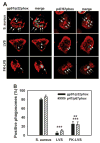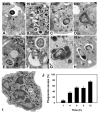Francisella tularensis LVS evades killing by human neutrophils via inhibition of the respiratory burst and phagosome escape
- PMID: 16908516
- PMCID: PMC1828114
- DOI: 10.1189/jlb.0406287
Francisella tularensis LVS evades killing by human neutrophils via inhibition of the respiratory burst and phagosome escape
Abstract
Francisella tularensis is a Gram-negative bacterium and the causative agent of tularemia. Recent data indicate that F. tularensis replicates inside macrophages, but its fate in other cell types, including human neutrophils, is unclear. We now show that F. tularensis live vaccine strain (LVS), opsonized with normal human serum, was rapidly ingested by neutrophils but was not eliminated. Moreover, evasion of intracellular killing can be explained, in part, by disruption of the respiratory burst. As judged by luminol-enhanced chemiluminescence and nitroblue tetrazolium staining, neutrophils infected with live F. tularensis did not generate reactive oxygen species. Confocal microscopy demonstrated that NADPH oxidase assembly was disrupted, and LVS phagosomes did not acquire gp91/p22(phox) or p47/p67(phox). At the same time, F. tularensis also impaired neutrophil activation by heterologous stimuli such as phorbol esters and opsonized zymosan particles. Later in infection, LVS escaped the phagosome, and live organisms persisted in the neutrophil cytosol for at least 12 h. To our knowledge, our data are the first demonstration of a facultative intracellular pathogen, which disrupts the oxidative burst and escapes the phagosome to evade elimination inside neutrophils, and as such, our data define a novel mechanism of virulence.
Figures






References
-
- Nauseef WM. Assembly of the phagocyte NADPH oxidase. Histochem Cell Biol. 2004;122:277–291. - PubMed
-
- Curnutte JT. Chronic granulomatous disease: the solving of a clinical riddle at the molecular level. Clin Immunol Immunopathol. 1993;67:S2–S15. - PubMed
-
- Oyston PCF, Sjostedt A, Titball RW. Tularemia: bioterrorism defence renews interest in Francisella tularensis. Nat Rev Microbiol. 2004;2:967–978. - PubMed
-
- Santic M, Molmeret M, Klose KE, Abu Kwaik Y. Francisella tularensis travels a novel, twisted road within macrophages. Trends Microbiol. 2006;14:37–44. - PubMed
Publication types
MeSH terms
Substances
Grants and funding
LinkOut - more resources
Full Text Sources
Other Literature Sources
Research Materials

